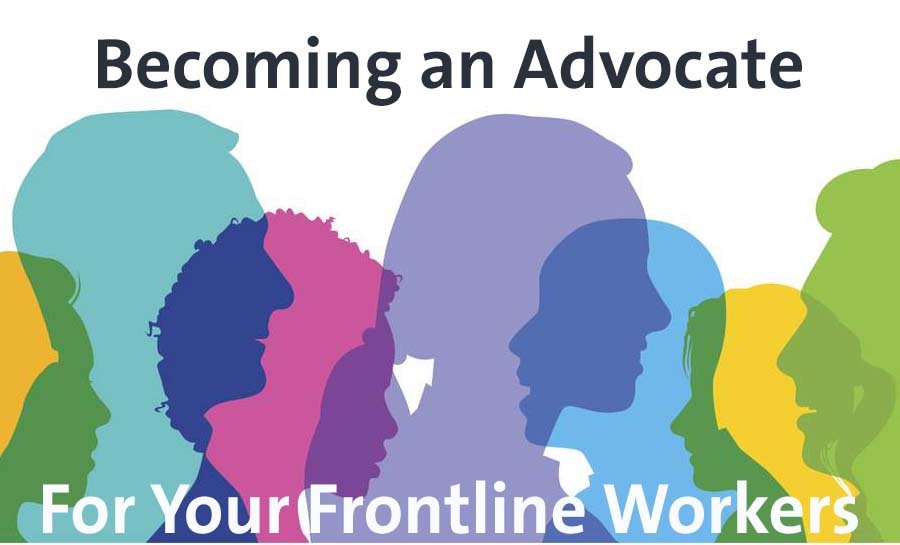Becoming an Advocate for Your Frontline Workers
Since the 1990s, healthcare jobs have been steadily ticking up, while former powerhouse employers such as the manufacturing industry were trending down. An article in The Atlantic, “Health Care Just Became the U.S.’s Largest Employer,” highlighted this growth, noting that healthcare outpaced both manufacturing and retail industries in 2017.
It’s a position that the healthcare sector is projected to hold for the next decade. This anticipated growth is driven in part by an aging population that will require more health-related services, a topic that healthcare has been discussing for decades. Now, with data supporting this growth in healthcare industry jobs coming from the Bureau of Labor Statistics (BLS), the Federal Reserve Economic Data (FRED) and other entities, the impact of an aging population driving the need for more healthcare workers is part of the general conversation, garnering coverage in main-stream media.
According to the BLS, healthcare jobs will grow more than any other industry from 2016 through 2026. The Atlantic article points to similar data from FRED, and further notes that the growth has been driven by non-clinical roles. And that’s not expected to change in the coming years. While you may have strategies in place to hire and retain nurses, doctors and other clinical professionals, do you have one in place for your frontline workers?
If not, you may find your organization isn’t able to be competitive in a jobs marketplace that’s wide open for hourly workers. In addition to competing with other healthcare organizations to fill positions, you’ll be competing with other industries such as retail or food service. Many businesses already have strategies in place to find and keep workers, offering higher wages, career paths, education assistance, and other benefits.
Finding and Keeping the “Right” Candidates
Across numerous service-related industries, the challenge is twofold: Getting employees to stay, and finding them in the first place. An article from the Society for Human Resource Management cites a PeopleMatter survey showing that finding enough high-quality job candidates is the #1 problem, but that the #2 industry workforce problem is turnover.
The article goes on to explain that when new people come onboard, the process “should do more than take care of paperwork; it should help new employees experience your unique culture, see how their work matters, know what’s expected of them, and help them picture a long-term career path with you.”
In fact, that approach is important well beyond the first few days or weeks of employment. Employees should consistently know that what they’re doing now is important and that if they aspire to grow within their organizations they are able to do so.
A long-term solution won’t be found in placing more recruitment ads or a new marketing campaign. It comes from a systemic approach that evaluates the entire frontline employee experience and creates a workforce development strategy that addresses the issues leading to high turnover and overall job dissatisfaction.
An Investment in Frontline Employees Is an Investment in Your Organization
Missouri-based Mercy, University Health System (Texas), U.C. Davis Health (California), and Yale New Haven Hospital (Connecticut) serve different types of communities and populations, but they have two things in common. They have all received national recognition for the healthcare services they provide and for making significant investments in the skills and careers of frontline workers, with each one recognized as 2017 CareerSTAT Frontline Health Care Worker Champions or Emerging Champions.
These organizations are clearly and strategically focused on their frontline employees and the reason is simple: Healthcare organizations that effectively become advocates for frontline workers are experiencing better outcomes for their employees. And this has a positive effect on organization and the patients they serve.
So what does an employee success story look like for a frontline employee? Elaine Thomas began her career in healthcare at East Alabama Medical Center (EAMC) in 1996 as a certified nurse assistant. After working in EAMC’s Skilled Nursing Facility for 10 years, and with encouragement from her manager, Elaine entered the SAW® program in 2006.
Soon after graduation, she accepted a promotion as an education department secretary. Elaine sustained her career ambition and desire to develop professionally. She became a basic life support instructor and took developmental leadership training classes offered by EAMC. In 2018, Elaine was again promoted, this time to education coordinator. Elaine regularly attends recruitment events and is a champion of EAMC’s development opportunities with the frontline staff.
Elaine’s success is based on three pillars: her desire to advance, the support of her manager, and the employee programs and training offered by her organization. Together, they made a solid foundation for her success, but take one away and her goal of career advancement might not have become a reality.
The not-so-hidden truth about effective frontline employee strategies is that they benefit both the employer and the employee, today and in the future. For organizations struggling to find “quality” hourly workers, the answer may not be in expanding recruitment efforts. Instead, hiring for organizational fit and providing basic skills training to help employees succeed in their current jobs can help a healthcare system fill those positions. Additional career training and support, along with other frontline worker strategies, allows employees the opportunity for career growth in the organization.
The end result is that frontline employees aren’t moving on, they’re moving up.
Sources:
“Health Care Just Became the U.S.’s Largest Employer.” January 9, 2018. Derek Thompson. The Atlantichttps://www.theatlantic.com/business/archive/2018/01/health-care-america-jobs/550079/
“Employment by major industry sector.” Bureau of Labor Statistics https://www.bls.gov/emp/tables/employment-by-major-industry-sector.htm
“Employers Struggle to Hire Hourly Workers as Turnover Rises.” July 31, 2015. Roy Maurer. Society for Human Resource Management
https://www.shrm.org/resourcesandtools/hr-topics/talent-acquisition/pages/hire-hourly-workers-turnover-rises.aspx
“6 Scary Numbers for Your Organization’s C-Suite.” October 30, 2018. Ryan Pendell. Gallup
https://www.gallup.com/workplace/244100/scary-numbers-organization-suite.aspx
National Fund For Workforce Solutions, https://nationalfund.org/
